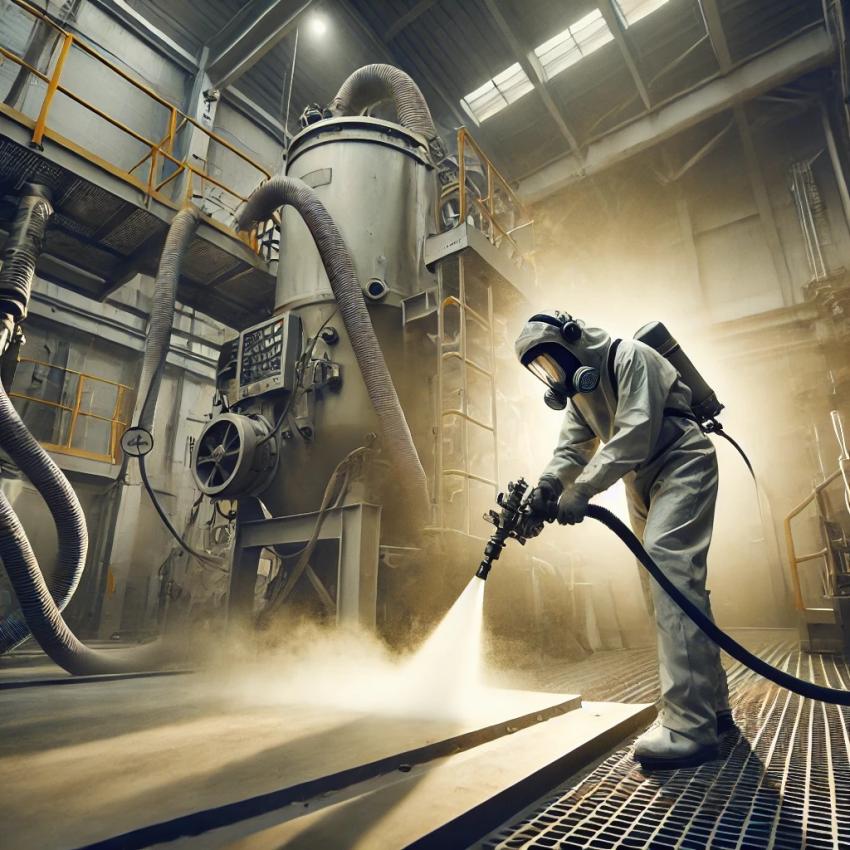How Is Steel Grit Blasting Used In Shipbuilding?

Introduction
Shipbuilding is a complex industry that requires precision, durability, and longevity. One of the critical processes in preparing ship surfaces is steel grit blasting. This technique ensures the removal of rust, old paint, and contaminants from metal surfaces, providing a strong foundation for coatings and paints that protect against corrosion.
In this article, we will delve into the importance of steel grit blasting in shipbuilding, how the process works, its advantages, and best practices to ensure efficiency and compliance with industry standards.
What is Steel Grit Blasting?
Steel grit blasting is a process that uses abrasive steel particles to clean and prepare metal surfaces. These steel grits are propelled at high velocity onto the surface of a ship's structure, effectively removing contaminants like rust, mill scale, and old coatings.
This method is widely used in marine engineering and shipbuilding because it: ✅ Increases surface roughness for better paint adhesion
✅ Removes corrosion and extends the life of the vessel
✅ Ensures uniform cleaning for a consistent finish
Why is Steel Grit Blasting Important in Shipbuilding?
Ships operate in harsh marine environments, where exposure to saltwater, humidity, and industrial pollutants accelerates metal deterioration. Without proper surface preparation, coatings and paints will fail, leading to costly repairs and compromised vessel integrity.
Key Benefits of Steel Grit Blasting in Shipbuilding
1️⃣ Superior Surface Preparation
Steel grit blasting ensures a clean, roughened surface, ideal for strong paint adhesion. This is essential for maintaining the protective coatings that guard against corrosion, water ingress, and chemical damage.
2️⃣ Increases Coating Durability
A properly prepared surface allows paints, primers, and anti-corrosion coatings to bond effectively, extending the lifespan of the coating and reducing maintenance costs.
3️⃣ Removes Contaminants Effectively
Steel grit blasting completely removes oxidation, welding scales, old paint, and other contaminants, preventing premature coating failure.
4️⃣ Eco-Friendly & Efficient
Compared to chemical cleaning methods, steel grit blasting is environmentally friendly, as the abrasives can be recycled multiple times.
5️⃣ Compliance with Marine Industry Standards
The shipbuilding industry follows strict regulations (ISO, SSPC, NACE, and IMO standards) for surface preparation, and steel grit blasting meets these requirements efficiently.
How Does the Steel Grit Blasting Process Work?
Steel grit blasting involves several crucial steps to ensure optimal surface preparation:
Step 1: Surface Inspection
Before blasting begins, inspect the surface to determine the level of corrosion, contamination, and the required blasting intensity.
Step 2: Selection of Steel Grit
Choosing the right grit size and hardness is essential.
Coarse steel grits are used for heavy corrosion removal.
Finer grits are ideal for smooth surface finishing.
Step 3: Blasting Process
Using specialized blasting equipment, the steel grits are forcefully propelled onto the ship’s metal surface using compressed air or centrifugal force.
Step 4: Dust & Residue Removal
Once the blasting is complete, any residual dust or debris is removed using vacuum systems or compressed air.
Step 5: Coating Application
After the surface is adequately prepared, primers and protective coatings are immediately applied to prevent flash rusting.
Types of Steel Grit Used in Shipbuilding
Different types of abrasive grits are used in shipbuilding based on their hardness, shape, and durability.
Steel Grit Type
Features
Best Use Case
GH (High Carbon)
Hard, angular shape
Heavy-duty rust removal
GL (Medium Carbon)
Moderately hard, durable
General ship maintenance
GP (Low Carbon)
Softer, rounder
Smooth finish & paint prep
Stainless Steel Grit
Non-rusting, clean
Delicate surface cleaning
Choosing the right grit type is crucial for efficiency and cost-effectiveness.
Safety Considerations in Steel Grit Blasting
Steel grit blasting is a high-risk process, requiring proper safety measures. Here are the key precautions:
✅ Personal Protective Equipment (PPE) – Operators must wear helmets, gloves, safety glasses, and respirators.
✅ Ventilation & Dust Control – Adequate air filtration systems prevent dust inhalation.
✅ Regular Equipment Maintenance – Ensure blasting machines are properly inspected to avoid malfunctions.
✅ Proper Waste Management – Collect and dispose of blasting residues according to environmental regulations.
Challenges & Solutions in Steel Grit Blasting
While steel grit blasting is highly effective, it comes with some challenges. Let’s explore common issues and solutions:
Challenge
Solution
High dust generation
Use dust collection systems & sealed blasting enclosures
Equipment wear & tear
Regular maintenance & replacement of worn-out parts
Environmental concerns
Use recyclable abrasives & proper waste disposal
Operator fatigue
Provide ergonomic suits & automated blasting options
By implementing modern blasting technologies, shipyards can improve efficiency, safety, and sustainability.
Conclusion
Steel grit blasting is an indispensable process in shipbuilding, ensuring that ships are durable, corrosion-resistant, and compliant with industry standards. By choosing the right abrasive materials, equipment, and safety measures, shipbuilders can enhance efficiency and longevity in their vessels.
Investing in proper steel grit blasting techniques not only extends the life of ships but also reduces maintenance costs and ensures environmental compliance. As technology advances, automated blasting systems and eco-friendly abrasives will further enhance the effectiveness and sustainability of this crucial process.
FAQs on Steel Grit Blasting in Shipbuilding
1. How does steel grit blasting compare to sandblasting?
Steel grit blasting is more durable and reusable than sandblasting. Steel grit provides a more uniform finish, while sandblasting produces more dust and is less eco-friendly.
2. How often should ships undergo steel grit blasting?
Ships should undergo grit blasting every 5-7 years, depending on their exposure to saltwater and corrosive environments.
3. Is steel grit blasting environmentally friendly?
Yes! Steel grit is recyclable up to 200 times, reducing waste and environmental impact compared to other abrasives.
4. Can steel grit blasting damage ship surfaces?
When done correctly, it does not damage ship surfaces. However, using the wrong grit type or excessive pressure can lead to over-roughening or pitting.
5. What is the cost of steel grit blasting for a ship?
Costs vary based on ship size, grit type, and labor. On average, steel grit blasting costs between $2 - $5 per square foot.
6. What are the latest advancements in steel grit blasting technology?
New developments include automated robotic blasting systems and eco-friendly abrasives, improving efficiency and reducing health risks.
